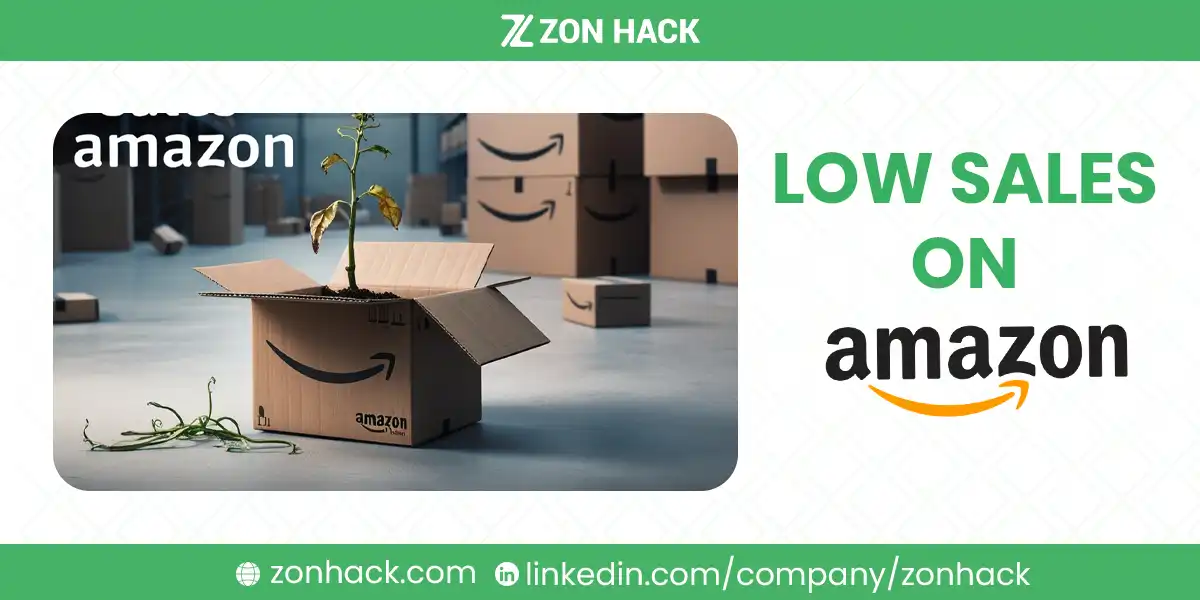Amazon’s massive e-commerce platform offers unmatched opportunities for sellers, but it’s not without challenges. Many sellers experience a dip in sales over time, leaving them frustrated and searching for answers. If you’re dealing with low sales, don’t panic—there’s always a way to turn things around. This article will walk you through identifying the root causes of declining sales and implementing proven strategies to get your business back on track.
How Amazon’s Sales Ecosystem Works
Selling successfully on Amazon requires more than just listing a product. The platform operates through a complex ecosystem influenced by numerous factors, and sellers must understand these dynamics to thrive.
Amazon’s Role in E-Commerce
Amazon dominates the online retail space, accounting for over 37% of all e-commerce sales in the U.S. in 2023. For sellers, this means access to millions of potential customers. However, it also means competing with over 1.9 million active sellers globally. While this competition might seem daunting, understanding how Amazon’s systems work can give you an edge.
Key Factors That Influence Sales
Several elements directly affect your sales on Amazon:
- Visibility: Products that appear on the first page of search results capture over 70% of clicks. Ranking high is essential.
- Pricing: Winning the Buy Box often depends on offering competitive prices.
- Reviews and Ratings: 79% of online shoppers trust product reviews as much as personal recommendations.
- Product Quality and Demand: No amount of marketing can sustain sales for a product that doesn’t meet customer expectations.
- Competition: Amazon’s marketplace is saturated with sellers offering similar products, making differentiation crucial.
The Algorithm Behind Sales: A9/A10
Amazon’s ranking algorithm, often referred to as A9 (or its updated version A10), determines product visibility. Factors such as conversion rates, relevance, and fulfillment methods significantly influence rankings. Unlike search engines like Google, Amazon’s primary focus is sales. This means that the better your product performs—through clicks, purchases, and reviews—the more likely it is to rank higher.
Debunking Myths
Many sellers mistakenly blame low sales solely on algorithm changes. While algorithms do play a role, factors like poor listing optimization, negative reviews, or inventory mismanagement often contribute to declining sales. By addressing these controllable aspects, you can see tangible improvements.
Diagnosing the Root Causes of Low Sales
Before jumping into solutions, it’s crucial to diagnose what’s causing your sales to drop. Start by analyzing internal and external factors that could be impacting performance.
Internal Factors
- Account and Listing Health
Amazon closely monitors seller accounts for performance metrics like order defect rates, late shipment rates, and Buy Box eligibility. If your account health is flagged, it can lead to suppressed listings or lower visibility.
For instance, a seller with an order defect rate exceeding 1% risks account suspension. Similarly, failing to meet Buy Box criteria, such as competitive pricing and fast shipping, can directly impact sales. Check your Account Health Dashboard regularly to ensure compliance.
- Listing Suppressions or Errors
Suppressed or incomplete listings are a common reason for low visibility. Issues like non-compliant images, excessively long titles, or missing information can result in your product being hidden from search results. Use Amazon’s Listing Quality Dashboard to identify and resolve these errors.
- Inventory Challenges
Both overstocking and stockouts can harm your sales. Running out of stock not only loses you immediate revenue but can also hurt your rankings. Conversely, overstocking ties up capital and increases storage fees. Tools like Restock Inventory Reports or third-party solutions like InventoryLab can help maintain optimal stock levels.
- Product Reviews and Feedback
Negative reviews or low ratings can deter potential buyers. For example, a product with a rating below 4 stars is significantly less likely to convert visitors into customers. Address negative reviews promptly by offering resolutions and improving product quality where needed.
External Factors
- Competitor Analysis
The competition on Amazon is fierce. A sudden drop in sales might indicate that competitors are outperforming you in price, promotions, or product quality. Tools like Helium 10 or Jungle Scout can help analyze competitors’ pricing strategies, keywords, and review trends.
For example, if a competitor launches a promotion while your price remains static, customers are likely to flock to their listing. Stay vigilant and adapt quickly to remain competitive.
- Market Trends and Seasonality
Sales fluctuations can also be seasonal or trend-driven. For instance, holiday-themed products experience surges in November and December but may drop off sharply afterward. Similarly, trending products like fidget spinners saw massive sales spikes in 2017, followed by rapid declines. Use tools like Google Trends or Amazon’s Best Sellers Rank to identify patterns.
- Economic Shifts
External factors like inflation, changing consumer priorities, or supply chain disruptions can impact sales. For example, during economic downturns, consumers often shift to budget-friendly alternatives. Adapting your pricing or marketing strategy to align with these changes can help mitigate losses.
Strategies to Boost Sales on Amazon
Once you’ve identified the issues, it’s time to implement strategies to address them and improve your sales.
1. Product Listing Optimization
Your product listing is your storefront, and first impressions matter. Listings with clear, compelling, and optimized content are more likely to convert visitors into buyers. Start by focusing on keyword optimization. Research and include high-traffic, relevant keywords in your titles, bullet points, and descriptions. Tools like SellerApp or Amazon Keyword Tool can help you identify these terms.
Next, invest in professional images and visuals. Listings with high-quality photos—including lifestyle images that show the product in use—see significantly higher conversion rates. If your brand is registered with Amazon, consider using A+ Content to create visually engaging product descriptions.
Finally, ensure your listings are mobile-friendly. With over 50% of Amazon’s traffic coming from mobile devices, a well-optimized mobile experience can make a significant difference in sales.
2. Strategic Pricing Adjustments
Price is often the deciding factor for many buyers. Regularly monitor your competitors’ pricing and adjust accordingly to stay competitive. Tools like Keepa or RepricerExpress can help you track price trends and automate adjustments. Offering limited-time promotions, such as Lightning Deals, can also boost visibility and sales, especially during peak shopping seasons.
3. Leveraging Amazon PPC Advertising
Amazon’s Pay-Per-Click (PPC) campaigns are a powerful way to drive traffic to your listings. Start with Sponsored Products ads to target customers searching for your keywords. Over time, analyze your campaign’s performance metrics, such as click-through rate (CTR) and Advertising Cost of Sales (ACoS), to refine your strategy. Effective PPC campaigns can increase visibility, drive sales, and improve your organic rankings.
4. Build and Maintain Positive Reviews
Customer reviews and ratings heavily influence purchase decisions. Products with higher ratings are often prioritized in Amazon search results.
Use Amazon’s automated request-a-review feature to encourage satisfied customers to leave feedback. Pair this with excellent customer service to ensure positive experiences.
Address negative reviews promptly and professionally. If a customer leaves a poor review about a product defect, offer a replacement or refund while updating your listing to reflect any improvements.
5. Inventory Management
Efficient inventory management prevents stockouts, reduces storage fees, and ensures you’re ready for spikes in demand.
Amazon tools like the Restock Inventory report or third-party solutions like InventoryLab help predict sales trends and avoid overstocking or understocking.
Combine Fulfillment by Amazon (FBA) with Fulfillment by Merchant (FBM) to balance storage costs and delivery speed. This approach ensures continuity during peak seasons or stockouts.
Plan your inventory months in advance for high-demand periods like Black Friday or Christmas. Adjust your order volumes based on historical sales data and current market trends.
For sellers aiming to not just recover but thrive, advanced strategies can help build a robust foundation for long-term success.
How to Build Your Brand Presence for Long-Term Success
Establishing a strong brand presence is key to standing out in a saturated marketplace. Register for Amazon Brand Registry to access enhanced tools like A+ Content, Amazon Stores, and anti-counterfeit measures.
Developing your own branded products allows you to set yourself apart from competitors offering similar items. It also gives you greater control over pricing and customer perception.
Build a loyal customer base through social media, email marketing, or dedicated websites. By engaging customers off Amazon, you reduce dependency on its marketplace.
Relying solely on Amazon can be risky. Diversifying your sales channels helps mitigate this dependence and expand your reach. Consider listing your products on platforms like Walmart, eBay, or Shopify. While these marketplaces may not have Amazon’s scale, they offer unique audiences.
FAQs
What are the top reasons for low Amazon sales?
The most common causes include poor visibility, ineffective pricing, low reviews, and inventory issues like stockouts.
How can I optimize my Amazon product listings effectively?
Focus on keyword placement, high-quality visuals, A+ Content, and ensuring mobile-friendliness.
What tools are best for Amazon seller analytics?
Popular tools include Helium 10, Jungle Scout, SellerApp, and Sellics.
How do I get more reviews without violating Amazon’s policies?
Use Amazon’s request-a-review feature and focus on delivering excellent customer experiences.
Should I diversify my business beyond Amazon?
Yes, expanding to other platforms like Shopify or Walmart reduces risk and broadens your customer base.
Why Choose ZonHack for Your Amazon Success?
ZonHack is your all-in-one solution for dominating the Amazon marketplace. Whether you’re struggling with product listings, optimizing SEO, running effective PPC campaigns, or analyzing business reports, ZonHack simplifies it all. Our expert team leverages cutting-edge tools and strategies to boost product visibility, drive conversions, and maximize ROI.
Beyond what’s covered in this article, we offer tailored insights, data-driven recommendations, and hands-on support for your unique needs. From launching products to managing complex campaigns, ZonHack ensures you stay ahead of the competition with measurable results. Let ZonHack unlock your Amazon success today, book a free strategy call now.




